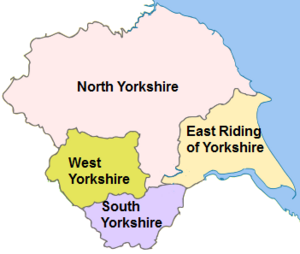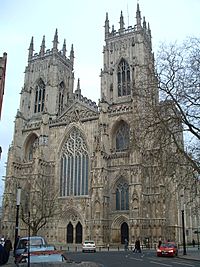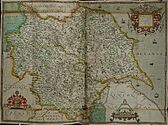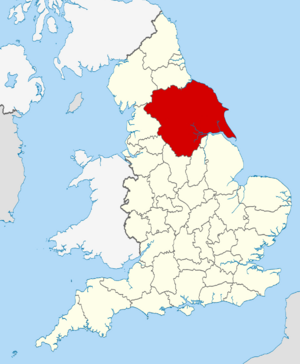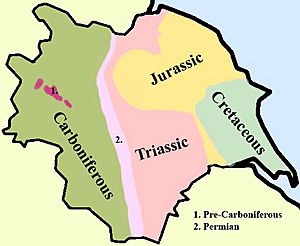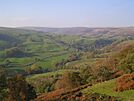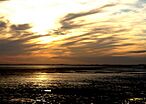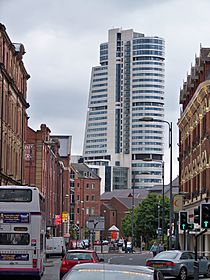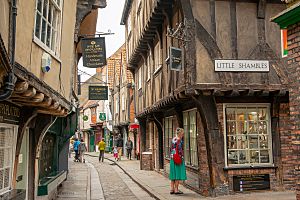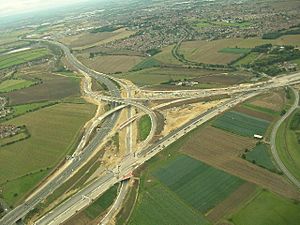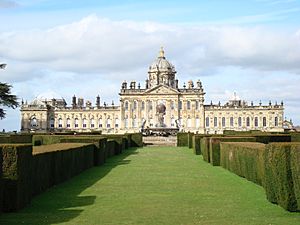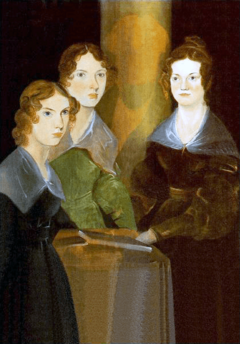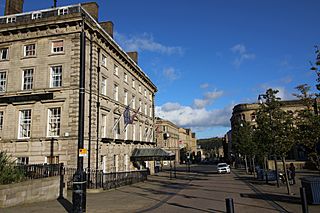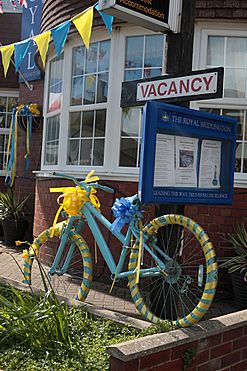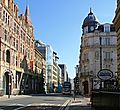Yorkshire facts for kids
| Yorkshire | |
| Geography | |
| Status | Historic county |
| Chapman code | YKS |
| History | |
| Origin | Kingdom of Jórvík |
| Succeeded by | Various |
Quick facts for kids Subdivisions |
|
|---|---|
| Type | Ridings (largest & most notable of differing former subdivisions) |
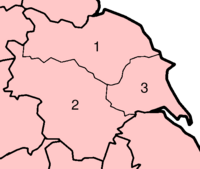 |
|
| Units | 1 North • 2 West • 3 East |
Yorkshire is a large area in Northern England. It was once a very important historic county. Even though it's not used for government today, people in Yorkshire feel a strong connection to their region. The county is named after its main city, York.
The southwest of Yorkshire is very busy, with big cities like Leeds, Sheffield, Bradford, and Wakefield. The north and east are quieter, but the port city of Kingston upon Hull is in the southeast. York is located in the middle of the area. Yorkshire has a coastline along the North Sea to the east. The North York Moors are in the northeast, and the Yorkshire Dales are in the northwest.
Historically, Yorkshire was the largest county in the United Kingdom. For hundreds of years, it was split into three main parts called "ridings": the North, East, and West. Each riding had its own local government. Today, Yorkshire gives its name to four modern areas: East Riding of Yorkshire, North Yorkshire, South Yorkshire, and West Yorkshire. These areas cover most of the historic county.
People celebrate Yorkshire Day every year on August 1st. It's a day to enjoy the culture of Yorkshire, its history, and its special way of speaking. The symbol of Yorkshire is a white rose. This rose was originally the symbol of the House of York, a British royal family. People sometimes call Yorkshire "God's own country."
Contents
- Understanding Yorkshire's Areas
- What Does "Yorkshire" Mean?
- Yorkshire's Past: A Journey Through Time
- Yorkshire's Landscape and Nature
- Cities and Towns of Yorkshire
- Yorkshire's Economy
- Getting Around Yorkshire
- Buildings and Architecture
- Yorkshire's Culture
- Sports in Yorkshire
- Images for kids
- See also
Understanding Yorkshire's Areas
Yorkshire can be described in different ways. It can mean the historic county or the group of four modern areas. The old county borders stayed mostly the same for a long time, from 1182 to 1889. After 1889, some small changes were made. For example, in 1934, Dore and Totley moved from Derbyshire to Yorkshire. This happened when they became part of Sheffield.
Bigger changes happened in 1974. The historic county was divided into several new counties. Most of the area became North Yorkshire, South Yorkshire, and West Yorkshire. A large part of the east went to Humberside, and a northern area went to Cleveland. Some rural parts moved to other counties like County Durham and Lancashire.
Both Cleveland and Humberside were later removed in 1996. Since then, there have been four main areas with "Yorkshire" in their names: East Riding of Yorkshire, North Yorkshire, South Yorkshire, and West Yorkshire. These areas cover most of the historic county.
There is also a larger region called Yorkshire and the Humber. This region is similar to the four Yorkshire areas combined. It includes some parts that were in Humberside but not historic Yorkshire. This region is mainly used for showing statistics.
What Does "Yorkshire" Mean?
The name "Yorkshire" means the "shire" (or administrative area) of the city of York. The word "York" has a very old history. It might come from an old Celtic word, "Eburakon." This word means "Place of yew trees." Yew trees were common around York, and people used their wood to make bows.
The Romans called it 'Eboracum.' Later, the Angles called it 'Eorfowic.' The Vikings then called it 'Jorvik.' So, the name has changed a lot over time, but it always connects back to the idea of the "yew tree."
Yorkshire's Past: A Journey Through Time
Early Times: Celtic Tribes
The first people in what became Yorkshire were ancient Celts. They formed different tribes. The Brigantes lived in the north and west. The Parisi lived in the area that is now the East Riding of Yorkshire. The Brigantes were a very powerful tribe. They controlled a large part of what is now Northern England.
The Parisi might have been related to a tribe in France, near where Paris is today. Their main town was Petuaria, close to the Humber Estuary.
Roman Rule: Britannia Inferior
The Romans started conquering Britain in 43 AD. But the Brigantes kept their kingdom for a long time. They were a "client state" of Rome, meaning they were allied with Rome. Their capital was Isurium Brigantum (near Aldborough).
Later, the Romans fully took control. The city of Eboracum (now York) became the capital of Britannia Inferior. It was also a joint capital for all of Roman Britain. Two Roman emperors, Septimius Severus and Constantius Chlorus, even ruled the Roman Empire from Eboracum. Constantius Chlorus's son, Constantine the Great, was declared emperor in York in 306 AD. He later became famous for accepting Christianity. Roman rule in Britain ended in the early 5th century.
Anglo-Saxon and Viking Kingdoms
After the Romans left, small Celtic kingdoms appeared. These included Deira (around Malton), Ebrauc (around York), and Elmet (to the west).
Then, people called the Angles arrived from northern Europe. They took over these kingdoms. York became the capital of Deira. Deira then joined with another kingdom, Bernicia, to form Northumbria. At its biggest, Northumbria stretched from the Irish Sea to the North Sea. Other groups like Frisians, Danes, and Franks also settled here.
The Viking Kingdom of Jórvík
In 866 AD, a large army of Danish Vikings invaded Northumbria. They conquered York and renamed it Jórvík. This became the capital of a new Danish kingdom. This kingdom covered most of southern Northumbria, which is roughly modern-day Yorkshire.
The Vikings also conquered a larger area of England called the Danelaw. But Jórvík was the only true Viking territory on mainland Britain. The kingdom became rich through trade with other Viking lands and beyond.
The first king of Jórvík was Halfdan Ragnarsson in 875. Most kings were Danish. But later, Norwegian kings ruled, like Eric Bloodaxe. He was the last independent Viking king of Jórvík.
The Kingdom of Jórvík ended around 954. The Kingdom of Wessex in southern England became very powerful. Yorkshire became part of Northumbria again, but it still had some independence. The English kings respected the Viking customs in Yorkshire.
Norman Conquest and Beyond
The Harrying of the North
In 1066 AD, before the Battle of Hastings, King Harold II of England was fighting in Yorkshire. He defeated a Viking invasion at the Battle of Stamford Bridge. But then he had to rush south to fight William the Conqueror. Harold lost the Battle of Hastings, and the Normans took over England.
In 1069 AD, people in the North rebelled against the Normans. They tried to take back York. William the Conqueror responded with the "Harrying of the North." He ordered his army to destroy crops, animals, and villages from York to Durham. Many people starved or died from the cold. It was a very harsh time.
After this, many abbeys and priories were built in Yorkshire. Norman landowners also created new towns like Barnsley, Doncaster, Hull, Leeds, Scarborough, and Sheffield.
Wars and Plagues
In the early 12th century, Yorkshire people fought the Scots at the Battle of the Standard. Soldiers from Yorkshire, led by Archbishop Thurstan of York, defeated the Scots.
The population grew until the Great Famine in 1315. After England lost the Battle of Bannockburn in 1314, the Scottish army raided northern England, including Yorkshire. The Black Death arrived in Yorkshire by 1349, killing about a third of the people.
Royal Conflicts and Industry
Wars of the Roses
In the 1400s, two royal families, the House of York and the House of Lancaster, fought for the English throne. These were the Wars of the Roses. Some battles happened in Yorkshire, like the Battle of Towton. This was one of the bloodiest battles ever fought in England. Richard III was the last Yorkist king.
Henry Tudor defeated Richard and became King. He married Elizabeth of York, which ended the wars. The white rose of York and the red rose of Lancaster combined to form the Tudor Rose. This old rivalry between York and Lancaster is still seen today, especially in sports between Yorkshire and Lancashire.
Religious Changes and Civil War
In the 1500s, King Henry VIII changed the religion of England. He closed down monasteries, which led to a protest in Yorkshire called the Pilgrimage of Grace. Later, during the reign of Elizabeth I, some Catholics in Yorkshire were executed for their beliefs. One famous example was Margaret Clitherow from York.
The English Civil War started in 1642. Yorkshire was divided. Hull famously refused to let the King enter. York was a base for the Royalists (supporters of the King). But the Parliamentarians (supporters of Parliament) eventually won control of Yorkshire after the Battle of Marston Moor.
Industrial Growth and Modern Times
Growth of Industry
In the 16th and 17th centuries, towns like Leeds, Huddersfield, Hull, and Sheffield grew. The wool industry became very important, especially in the West Riding of Yorkshire. Mills were built along rivers to use water power. Coal mining also became a major industry.
The Victorian Revolution
The 19th century saw Yorkshire continue to grow. The Industrial Revolution brought more coal, textile, and steel industries, especially in Sheffield and Middlesbrough. However, living conditions in towns became crowded and unhealthy. But by the end of the century, new sewers and water supplies improved things. Many railway lines were built, connecting towns across the county.
Canals and turnpike roads (toll roads) were also built. Spa towns like Harrogate and Scarborough became popular. People believed the mineral water there had healing powers.
In 1889, local governments changed. Instead of one council for all of Yorkshire, each of the three ridings got its own council. Larger towns like Bradford, Leeds, and Sheffield became "county boroughs." This meant they were independent from the riding councils.
Twentieth Century to Today
During the Second World War, Yorkshire was important for RAF Bomber Command. Its factories were targets for German bombers.
Since the late 20th century, local government in Yorkshire has changed many times. The old ridings and county boroughs were removed in 1974. New counties like North Yorkshire, South Yorkshire, and West Yorkshire were created. Some areas also went to Humberside and Cleveland.
Humberside and Cleveland were later abolished in 1996. Today, the four ceremonial counties of East Riding of Yorkshire, North Yorkshire, South Yorkshire, and West Yorkshire cover most of the historic county.
Yorkshire's Landscape and Nature
Historically, Yorkshire's northern border was the River Tees. The North Sea was to the east, and the Humber Estuary and Rivers Don and Sheaf were to the south. The western border followed the Pennine Hills.
Geology: The Land's Story
The different parts of Yorkshire have different types of rock, which shaped the landscape. The Pennine hills in the west are made of Carboniferous rock. The central valley has Permo-Triassic rock. The North York Moors in the northeast are Jurassic rock. The Yorkshire Wolds in the southeast are Cretaceous chalk hills.
Rivers: Waterways of Yorkshire
Many rivers flow through Yorkshire. In the west and center, rivers flow into the River Ouse. The Ouse then reaches the North Sea through the Humber Estuary. The River Swale and River Ure are in the north. The River Nidd flows through Nidderdale. The River Wharfe drains Wharfedale. The Rivers Aire, Calder, and Don are in the south. The River Derwent flows from the North York Moors.
In the far north, the River Tees flows into the North Sea near Middlesbrough. The smaller River Esk reaches the sea at Whitby. The River Hull flows south to the Humber Estuary at Kingston upon Hull.
The western Pennines are drained by the River Ribble. This river flows west and eventually reaches the Irish Sea.
Beautiful Landscapes
People in Yorkshire often call their countryside "God's Own County." Yorkshire includes the North York Moors and Yorkshire Dales National Parks. Part of the Peak District National Park is also here. Nidderdale and the Howardian Hills are special "Areas of Outstanding Natural Beauty."
The coast has rugged cliffs, like the jet cliffs at Whitby and the chalk cliffs at Flamborough Head. Spurn Point is a narrow sand spit, a special nature reserve.
The highest mountains in Yorkshire are in the Pennines. Mickle Fell is the highest point in the North Riding. Whernside is the highest in the West Riding. Whernside, Ingleborough, and Pen-y-Ghent are known as the "Yorkshire Three Peaks." Many people enjoy hiking them.
The Royal Society for the Protection of Birds has nature reserves here. For example, at Bempton Cliffs, you can see seabirds like northern gannets and Atlantic puffins. Yorkshire also has popular seaside resorts with sandy beaches. Scarborough is Britain's oldest seaside resort.
Cities and Towns of Yorkshire
Yorkshire has eight officially recognized cities: Bradford, Doncaster, Kingston upon Hull, Leeds, Ripon, Sheffield, Wakefield, and York. York has been a city since ancient times. Other cities were given their status by the monarch, often because they grew very large.
| City | Status conferred | Territory holding status | Population 2021 |
|---|---|---|---|
| Bradford | 1897 | Metropolitan borough | 546,500 |
| Doncaster | 2022 | Metropolitan borough | 308,100 |
| Kingston upon Hull | 1897 | Unitary authority | 267,100 |
| Leeds | 1893 | Metropolitan borough | 812,000 |
| Ripon | 1865 | Civil parish | 16,589 |
| Sheffield | 1893 | Metropolitan borough | 556,500 |
| Wakefield | 1888 | Metropolitan borough | 353,300 |
| York | Time immemorial | Unitary authority | 202,800 |
The largest built-up areas in Yorkshire at the 2021 census were:
|
Largest built-up areas in Yorkshire
2021 Census |
||
|---|---|---|
| Rank | Pop. | |
| 1 | Leeds | 536,280 |
| 2 | Sheffield | 500,535 |
| 3 | Bradford | 333,950 |
| 4 | Kingston upon Hull | 270,810 |
| 5 | Middlesbrough | 148,215 |
| 6 | York | 141,685 |
| 7 | Huddersfield | 141,675 |
| 8 | Wakefield | 97,870 |
| 9 | Halifax | 88,115 |
| 10 | Doncaster | 87,455 |
Yorkshire's Economy
South and West Yorkshire
Leeds is Yorkshire's biggest city. It is a major center for business and finance in the UK. Leeds used to have many different industries, including textiles and coal mining. Tourism is also growing in the city. In 2015, tourism brought in over £7 billion.
Cities like Bradford, Halifax, and Huddersfield were once important for wool production. Some of these areas have faced economic challenges as industries changed.
Sheffield was famous for its heavy industries, like coal mining and steel. Now, Sheffield has more service and office businesses. Large shopping centers like Meadowhall are examples of this change.
Coal mining was very active in the south of the county for a long time. This was especially true around Barnsley and Wakefield. However, the industry declined, and the last coal pit in the area closed in 2013.
East Riding and North Yorkshire
North Yorkshire has a strong tourist industry. This is thanks to its two national parks, the Yorkshire Dales and North York Moors. Cities like Harrogate and York also attract many visitors.
Tourism is a huge part of York's economy. In 2019, it brought in over £765 million and supported 24,000 jobs. Harrogate is known for its conference facilities. These events alone brought 300,000 visitors to Harrogate in 2016.
Kingston upon Hull is Yorkshire's largest port. It also has many factories. While its fishing industry has shrunk, many businesses are still based in Hull. These include Aunt Bessie's and Birds Eye.
PD Ports operates Teesport near Middlesbrough and Redcar. They also run the Hull Container Terminal. Other businesses in these areas include Plaxton (Scarborough) and McCains (Scarborough).
Getting Around Yorkshire
The oldest road in Yorkshire is the Great North Road, now called the A1. It goes through the middle of the county, connecting London to Edinburgh. The M62 motorway crosses Yorkshire from east to west. The M1 brings traffic from London to Yorkshire.
The East Coast Main Line is a major railway line. It runs between London and Scotland, parallel to the A1. The Trans Pennine rail link connects Hull to Liverpool, passing through Leeds.
Before trains, seaports like Hull and Whitby were important for moving goods. Canals were also used, such as the Leeds and Liverpool Canal, England's longest canal. You can travel to Europe from Hull using ferry services.
Yorkshire also has air transport from Leeds Bradford Airport. This airport has grown a lot since 1996. Another airport, Doncaster Sheffield Airport, closed in 2022.
Buildings and Architecture
Old Forts and Castles
Many castles were built in Yorkshire after the Normans arrived. These include Bowes Castle, Pickering Castle, Richmond Castle, Skipton Castle, and York Castle. Later castles like Helmsley, Middleham, and Scarborough were built to defend against the Scots. The remains of these castles are popular places to visit today.
Grand Homes
Yorkshire has many grand stately homes. Some are even called "castles," like Allerton Castle and Castle Howard. Castle Howard and Harewood House are among the nine "Treasure Houses of England."
Other large estates with impressive buildings include Brodsworth Hall and Wentworth Woodhouse. Many properties are looked after by the National Trust, like Nunnington Hall.
Industrial Buildings
Buildings from the Victorian era are found across the region. West Yorkshire has many old cotton mills. The Leeds Corn Exchange and the Halifax Piece Hall are other examples of industrial architecture.
Town Halls and Public Buildings
Many important public buildings were built for local governments. Some famous ones include Leeds Town Hall, Sheffield Town Hall, Wakefield County Hall, and York Guildhall.
Religious Buildings

Yorkshire has many beautiful religious buildings. Some, like Bolton Abbey and Fountains Abbey, are now ruins. They were destroyed during the Dissolution of the Monasteries under King Henry VIII.
Important religious buildings still in use include York Minster, which is one of the largest Gothic cathedrals in northern Europe. Other notable buildings are Beverley Minster, Bradford Cathedral, and Ripon Cathedral.
Yorkshire's Culture
The culture of Yorkshire is a mix of many different groups who lived there. These include the Celts, Romans, Angles, Norse Vikings, and Normans. People from Yorkshire are very proud of their county and its culture. They often feel a strong connection to Yorkshire.
Yorkshire people have their own special dialects and accents. These are sometimes called "Broad Yorkshire" or Tykes. The language has roots in Old English and Old Norse. The dialect can vary a lot between different parts of Yorkshire. For example, the dialect in North Yorkshire is different from West Yorkshire.
One of Yorkshire's traditions is the Long Sword dance. The most famous traditional song is On Ilkla Moor Baht 'at ("On Ilkley Moor without a hat"). It is considered the unofficial song of the county.
Stories and Art
Yorkshire is home to famous writers. The Brontë sisters – Anne Brontë, Charlotte Brontë, and Emily Brontë – lived near Haworth. This area is now called Brontë Country. Their novels, like Jane Eyre and Wuthering Heights, are famous English books. Their old home is now a museum.
Bram Stoker wrote Dracula while living in Whitby. His book includes local stories from the area. Other well-known Yorkshire authors include J. B. Priestley and Alan Bennett. James Herriot wrote best-selling books about his life as a veterinarian in North Yorkshire.
Famous poets from Yorkshire include Ted Hughes and W. H. Auden. Yorkshire has also produced famous sculptors like Henry Moore and Barbara Hepworth. Some of their works can be seen at the Yorkshire Sculpture Park. There are many art galleries in Yorkshire, such as Leeds Art Gallery.
Food and Drink
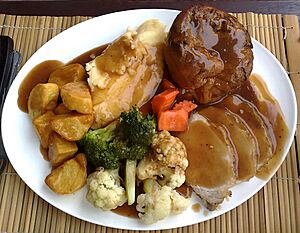
Yorkshire's traditional food uses rich ingredients. The most famous Yorkshire food is Yorkshire pudding. This savory dish is eaten all over England, often with roast beef. Traditionally, it was served as a starter with onion gravy. Yorkshire pudding is also the base for toad in the hole, which includes sausage.
Other foods from Yorkshire include Yorkshire curd tart and parkin, a ginger cake. Wensleydale cheese is made in Wensleydale. Ginger beer also came from Yorkshire. Liquorice sweet was first made in Pontefract in the 1760s. York was important for the confectionery industry, with chocolate factories like Rowntree's and Terry's.
In recent years, curries have become very popular in Yorkshire. This is due to the many Asian families who have moved there.
Beer and Brewing
Yorkshire has many breweries, like Black Sheep and Theakstons. The most common type of beer from Yorkshire is bitter. Brewing has been a big industry here since at least the 12th century.
Music Scene
Yorkshire has a rich history of folk music and dance. The song 'On Ilkla Moor Baht 'at' is an unofficial anthem. Famous folk singers from the county include the Watersons and Kate Rusby. Yorkshire has many folk clubs and festivals.
In classical music, Yorkshire has produced composers like Frederick Delius. Opera North is based in Leeds. Leeds also hosts the Leeds International Piano Competition. Yorkshire is home to successful brass bands, such as Black Dyke.
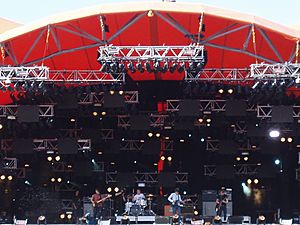
In popular music, David Bowie hired musicians from Hull for his famous album Ziggy Stardust. Def Leppard from Sheffield became world-famous in the 1980s. Yorkshire had a strong post-punk music scene with bands like the Human League and Soft Cell. In the 21st century, indie rock bands like the Kaiser Chiefs and Arctic Monkeys gained popularity. The Arctic Monkeys hold the record for the fastest-selling debut album in British music history.
TV and Film
Many British TV shows are filmed in Yorkshire. These include the soap opera Emmerdale and the comedy Last of the Summer Wine. The latter is the longest-running comedy series in the world. Other shows set in Yorkshire include Downton Abbey and All Creatures Great and Small.
Yorkshire is also a popular place for filming movies. Films like Kes, Brassed Off, and The Full Monty are set here. The Full Monty, a comedy set in Sheffield, won an Academy Award.
Sports in Yorkshire
Yorkshire has a long history in sports. People enjoy cricket, football, rugby league, and horse racing.
Cricket
Yorkshire County Cricket Club represents the county in cricket. They have won the championship 33 times, more than any other county. Many great cricketers were born in Yorkshire, including Geoffrey Boycott and Joe Root.
Football
Association Football
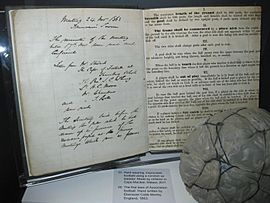
Yorkshire is officially recognized as the birthplace of club football. Sheffield FC, founded in 1857, is the oldest football club in the world. The first inter-club match was played in Yorkshire. The worldwide Laws of the Game were written by Ebenezer Cobb Morley from Hull.
Many famous football clubs are from Yorkshire. Four of them have won league titles: Huddersfield Town, Leeds United, Sheffield United, and Sheffield Wednesday. Huddersfield was the first club to win three league titles in a row.
Famous players from Yorkshire include World Cup-winning goalkeeper Gordon Banks and Kevin Keegan.
Rugby League
The sport of rugby league was founded in 1895 at the George Hotel in Huddersfield. This happened after a split from rugby union. Top Yorkshire clubs include Huddersfield Giants, Hull FC, and Leeds Rhinos.
Other Sports
In boxing, "Prince" Naseem Hamed from Sheffield achieved great fame. Nicola Adams from Leeds became the first female boxer to win an Olympic gold medal in 2012.
Many athletes from Yorkshire competed in the 2012 Summer Olympics. They won more gold medals than some entire countries! Famous athletes include Jessica Ennis-Hill (track and field) and the Brownlee brothers, Jonathan and Alistair (triathlon).
Yorkshire has nine horse racing courses, including York and Doncaster. England's oldest horse race, started in 1519, is run at Kiplingcotes.
The sport of Knurr and Spell was once very popular in Yorkshire. It was unique to the region.
Cycling
Yorkshire is very keen on cycling. In 2014, Yorkshire hosted the start of the Tour de France. About 2.5 million people watched, making it the most-attended event in the UK. The first Tour de Yorkshire race was held in 2015. Yorkshire also hosted the 2019 UCI Road World Championships. Famous cyclists from Yorkshire include Brian Robinson and Lizzie Deignan.
Field Hockey
Field Hockey is popular in Yorkshire, with many clubs and teams. Barry Middleton, England's most capped player, is from Doncaster.
Images for kids
See also
 In Spanish: Yorkshire para niños
In Spanish: Yorkshire para niños


